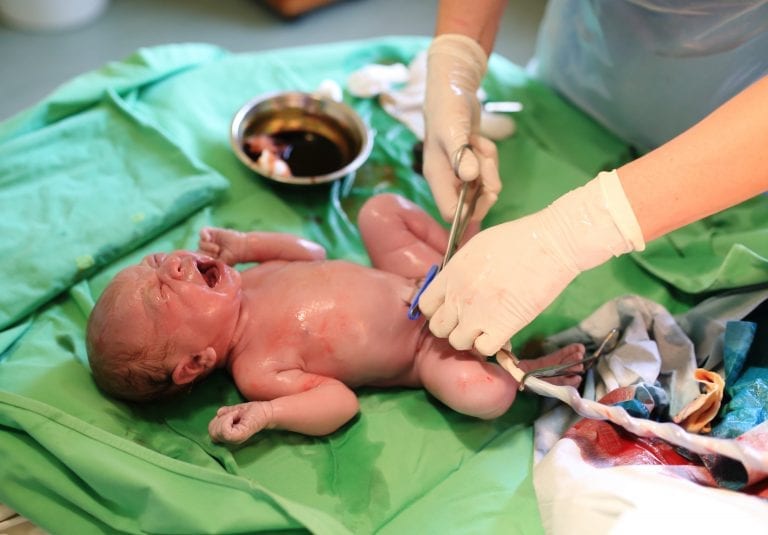What was a promise of potential future treatment is now more mainstream than ever before with new advancements in cord blood banking with both cord blood stored privately or donated to a public bank.
Since the first umbilical cord blood transplant in 1988, using stem cells taken from umbilical cord blood to treat diseases has grown considerably. Umbilical cord blood can be used to treat more than 80 blood-borne cancers and other diseases, and to date more than 25,000 patients around the world have received cord blood transplants. What started as a promise of future treatment is more mainstream occurrence now more than ever before.
Primarily, stem cells can regenerate a person’s blood or immune system. After transplant into a patient, the stem cells move to the person’s bone marrow where they multiply and regenerate cells, creating a new blood and immune system.
Still, despite advances in research and therapies, most pregnant women don’t save or donate their baby’s cord blood or placenta. According to the non-profit Save the Cord Foundation, of the 4 million births in the US each year, 97% of women don’t donate or bank their child’s cord blood and it’s discarded as medical waste.
Saving Your Baby’s Cord Blood
At birth, you have an option to save and bank—or donate—your baby’s cord blood, which is the blood left in baby’s umbilical cord and placenta post-birth. Both the blood and the umbilical cord tissue contain stem cells, and stem cells have the potential to change into various types of specialized cells, like nerve, skin, muscle, and blood cells.
Cord blood is useful to help family members as well as others, especially if you donate your cord blood and placental tissue to a public cord blood bank. To date, cord blood stem cells have been useful in treating many cancers, immune deficiencies and genetic disorders, such as sickle cell disease, leukemia, and lymphoma.
Stem cells treatments can be advantageous over bone marrow-based treatments as they can be used within a wider group of people than bone marrow, which generally requires a perfect match between the donor and recipient.
Expanding Regenerative Medicine
Among current advances, cord blood stem cells are helping regenerate injured cardiac tissue after a heart attack, and research is progressing with what some describe as “great promise” on the use of umbilical cord blood as what’s called “regenerative medicine.” In regenerative medicine, stem cells hold the promise of being used to treat different neurological diseases and complications including potentially reversing impairment caused by Alzheimer’s disease, minimizing traumatic brain injury, repairing spinal cord injuries, and treating autism spectrum disorder, cerebral palsy, hearing loss, and diabetes, to name but a few.
As the number of potential therapies continue to increase, more health care experts are encouraging parents to save or donate their baby’s cord blood and placental tissue. Donating to a public cord blood bank means your baby’s cord blood is available to anyone in need or for research.
Plan Ahead to Save Your Baby’s Umbilical Cord Blood
Experts writing in the journal, Nature, caution pregnant women to plan if they want to bank or donate their baby’s umbilical cord blood, as this requires completing paperwork and arranging with the hospital where you plan to birth to facilitate the donation at birth.
Cord blood research began nearly 50 years ago, and the first cord blood banks began in 1988, still experts don’t know how long the cryogenically frozen stem cells will last in storage. To date, stem cells stored since cord blood banks began have been successfully used for treatments in both donors and others, say experts at Save the Cord Foundation.
Most public banks accept cord blood bank donations without charge, although the hospital where you’re birthing may charge to collect and manage the donation. Private banks typically charge an initial storage fee plus annual maintenance fees, and may charge for collection kits and shipping.
Many people bank umbilical cord blood for private use in the event their child or a family member develops a disorder treatable with umbilical cord blood transplant. As you make decisions related to your baby’s post-birth cord blood and placenta, consider that the American Academy of Pediatrics estimates that the likelihood of using your babies cord blood for a disease they develop later in life is 1 in 200,000. The journal, Bone Marrow Transplant, reports public banks have released approximately 30 times more umbilical cord blood units for therapy than private banks.
Consider Cord Blood Banking
- Do you have a family member with a disease treatable with cord blood transplant? Some private cord blood banks offer banking for little or no cost to eligible families
- Do you want to donate to a public cord blood bank? You may be helping someone who needs a stem cell transplant. Learn if the hospital where you will give birth participates in a public cord blood bank, or how to donate to a public hospital at savethecord.org
Did you know? Nearly 800,000 cord blood units are in public banks, and more than 5 million samples are stored in private banks.






Comments are closed.